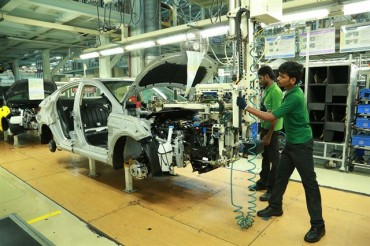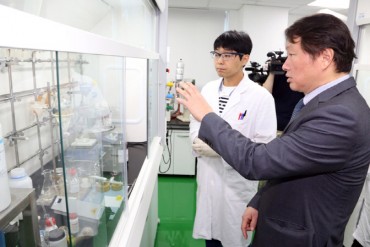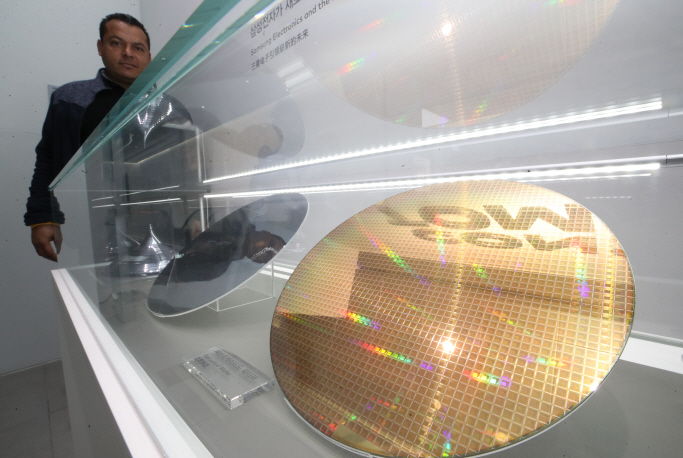
A silicon wafer is on display at Samsung Electronics Co.’s Seoul building in this photo taken April 1, 2019. (Yonhap)
SEOUL, Apr. 1 (Korea Bizwire) — The party is over for South Korean memory chip makers after a two-year boom, and deep-pocketed industry leaders are now looking to the future to find the new growth drivers in the non-memory chip business.
Samsung Electronics Co. and SK hynix Inc., the world’s two largest memory chip makers, reaped record-high profits in 2017 and 2018 on the back of strong demand for and price rallies in DRAM and NAND flash, but they are facing headwinds due to the unfavorable business environment.
With slowing orders from data servers and falling memory chip rices, market watchers expect the South Korean tech titans to post sluggish earnings in the first quarter and for the slump to continue through the second quarter.
According to a recent survey of 26 semiconductor experts and industry analysts by the state-run Korea Institute for Industrial Economics and Trade, 85 percent were pessimistic about the memory chip market this year.
Industry tracker DRAMeXchange anticipated PC DRAM contract prices to dip a worse-than-expected 30 percent in the first quarter amid a high level of inventory and saw no rebound in the near term.
“In today’s DRAM spot market, the overall momentum is not ideal,” DRAMeXchange said. “The buyers still show little willingness to purchase, and the trading conditions remain restrictive.”
South Korea holds a more than 60 percent market share in the memory sector, but Samsung and SK hynix still have a relatively weak presence in the non-memory sector, which is led by such U.S. giants as Intel and Qualcomm.
DRAM is a type of primary system memory mostly used in servers, and NAND is a non-volatile memory chip for mobile devices and other devices.
Non-memory chips comprise a broad range of semiconductor products, including processors, chipsets and image sensors.
According to global research firm Gartner, the value of the non-memory chip market was estimated at $346.6 billion last year — 65 percent of the total — more than twice that of the memory chip sector.
While it may be a make-or-break moment for tech companies that face toughening global competition, the bad news for the industry has also raised eyebrows among policymakers in Asia’s fourth-largest economy, which relies heavily on exports for its growth.
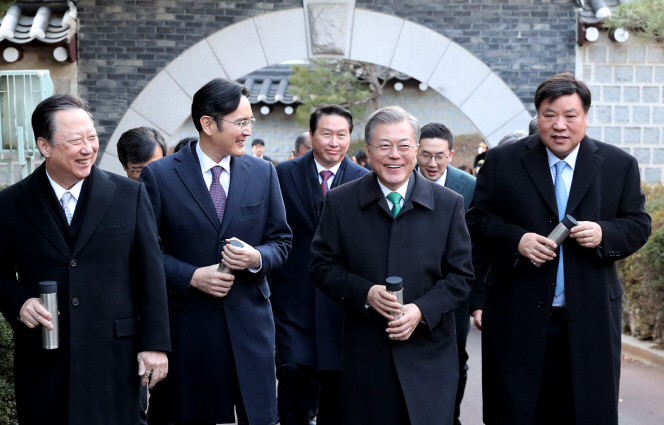
President Moon Jae-in (2nd from R) takes a walk in a garden at Cheong Wa Dae with South Korean business leaders on Jan. 15, 2019. Samsung Vice Chairman Lee Jae-yong (2nd from L) and SK Chairman Chey Tae-won (C, back row) were among the businesspeople. (Yonhap)
President Moon Jae-in has repeatedly called for the government and the industry to come up with measures to develop the non-memory sector to ease the nation’s dependence on the memory chip business.
Last week, Prime Minister Lee Nak-yon visited SK hynix’ Chongqing factory in China’s southwest and discussed ways to develop the non-memory sector with company officials.
Lee’s visit came as China continued bolstering its bid to develop its own semiconductor industry and cut its heavy dependence on foreign imports.
South Korea’s exports fell 8.2 percent in March from a year earlier, the trade ministry said Monday, citing falling global memory chip prices coupled with the slowing Chinese economy.
Semiconductor exports accounted for about 20 percent of South Korea’s total shipments last year and made up over 90 percent of its export growth, according to the Korea International Trade Association (KITA). Among the semiconductor exports, memory chips accounted for a whopping 74.2 percent of the total.
As the downcycle has been widely expected since late 2018, the manufacturers have been shifting their focus to develop new growth drivers to diversify their portfolio, jacking up investment in emerging technologies.
Samsung Vice Chairman Lee Jae-yong stressed the company needs to explore new business opportunities to keep its growth momentum in the highly competitive market.
“To overcome the stagnant memory chip market, we need to improve the competitiveness of the automotive semiconductor, sensor, foundry and system semiconductor businesses,” Lee said at a gathering of senior company officials in January.
In a meeting with a ruling party floor leader in late January, Lee said the company aims to bolster its non-memory chip and foundry business to snatch the top spot in the sector by 2030.
Fabless chip makers, such as U.S. tech behemoths Qualcomm and Broadcom, design and sell semiconductors for various types of electronics, but they source the work to foundries to benefit from lower capital costs.
According to market researcher TrendForce, Taiwan’s TSMC held 56.1 percent of the global foundry market in the first half of 2018. Samsung, which ranked fourth with a 7.4 percent share, is actively promoting its multi-project wafer service among potential clients to explore new cooperation possibilities.
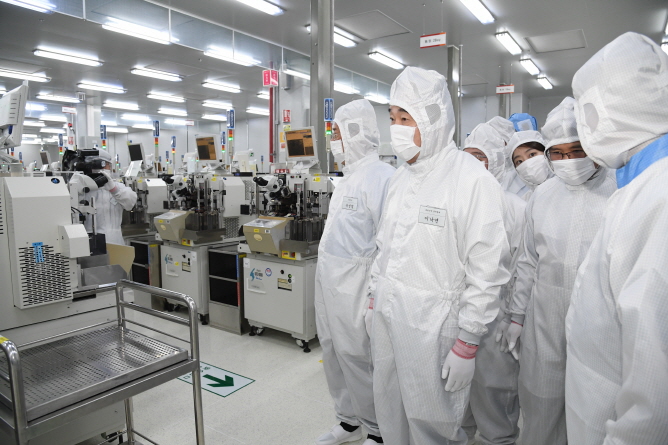
Lee Nak-yon (2nd from L), South Korea’s prime minister, visits SK hynix Inc.’s Chongching factory in southwestern China on March 29, 2019. (Yonhap)
SK hynix, which mostly earns revenue from DRAM and NAND flash, is also stepping up investment in non-memory technologies, including image sensors.
During the South Korean premier’s plant visit, Lee Sang-seon, an SK hynix vice president, said the company will focus on CMOS image sensors to provide higher speed and superior image quality for vehicles.
Experts say the major vendors should make efforts to hold onto their leading position and develop emerging technologies to fend off challenges from up-and-coming Chinese firms.
As the application processor market for smartphones and tablets continues to be saturated, they have called attention to areas with stronger prospects for growth, including wearables, the Internet of Things (IoT) and automotive applications.
“The current rankings may see significant change this year with the expectation that memory market conditions will weaken in 2019,” said Andrew Norwood, vice president at market researcher Gartner. “Technology product managers must prepare for this limited growth to succeed in the semiconductor industry.”
(Yonhap)




